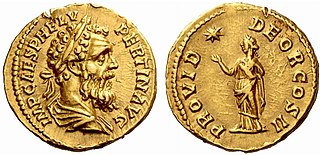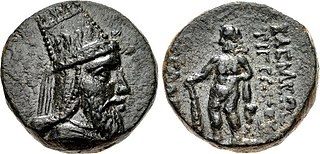
In ancient Roman religion, Ceres was a goddess of agriculture, grain crops, fertility and motherly relationships. She was originally the central deity in Rome's so-called plebeian or Aventine Triad, then was paired with her daughter Proserpina in what Romans described as "the Greek rites of Ceres". Her seven-day April festival of Cerealia included the popular Ludi Ceriales. She was also honoured in the May lustratio of the fields at the Ambarvalia festival, at harvest-time, and during Roman marriages and funeral rites. She is usually depicted as a mature woman.

In ancient Roman religion, Abundantia, also called Abundita or Copia, was a divine personification of abundance and prosperity. The name Abundantia means plenty or riches. This name is fitting as Abundantia was a goddess of abundance, money-flow, prosperity, fortune, valuables, and success. She would help protect your savings and investments. Abundantia would even assist someone with major purchases. She was among the embodiments of virtues in religious propaganda that cast the emperor as the ensurer of "Golden Age" conditions. Abundantia thus figures in art, cult, and literature, but has little mythology as such. She may have survived in some form in Roman Gaul and medieval France. Abundantia would carry a cornucopia that was filled with grain and coins. She would occasionally leave some of her grain or money at someone's house as a gift.
Bonus Eventus was a divine personification in ancient Roman religion. The Late Republican scholar Varro lists him as one of the twelve deities who presided over agriculture, paired with Lympha, the goddess who influenced the water supply. The original function of Bonus Eventus may have been agricultural, but during the Imperial era, he represents a more general concept of success and was among the numerous abstractions who appeared as icons on Roman coins.

In ancient Roman culture, liberalitas was the virtue of giving freely, hence generosity. On coins, a political leader of the Roman Republic or an emperor of the Imperial era might be depicted as displaying largess to the Roman people, with liberalitas embodied as a goddess at his side. The goddess Liberalitas appears on coinage issued under the emperors Gordian III Trajan, Antoninus Pius and Septimius Severus, sometimes designated as Augusta or Augusti in association with Imperial cult. On one example, a Roman holds out his toga to receive coins poured by Liberalitas, as Antoninus looks on from an elevated seat.

In ancient Roman religion, the diiNovensiles or Novensides are collective deities of obscure significance found in inscriptions, prayer formulary, and both ancient and early-Christian literary texts.

Pietas, translated variously as "duty", "religiosity" or "religious behavior", "loyalty", "devotion", or "filial piety", was one of the chief virtues among the ancient Romans. It was the distinguishing virtue of the founding hero Aeneas, who is often given the adjectival epithet pius ("religious") throughout Virgil's epic Aeneid. The sacred nature of pietas was embodied by the divine personification Pietas, a goddess often pictured on Roman coins. The Greek equivalent is eusebeia (εὐσέβεια).

In ancient Roman religion, Providentia is a divine personification of the ability to foresee and make provision. She was among the embodiments of virtues that were part of the Imperial cult of ancient Rome. Providentia thus figures in art, cult, and literature, but has little or no mythology as such.

In ancient Roman religion, Spes was the goddess of hope. Multiple temples to Spes are known, and inscriptions indicate that she received private devotion as well as state cult.

In ancient Roman religion, Vica Pota was a goddess whose shrine (aedes) was located at the foot of the Velian Hill, on the site of the domus of Publius Valerius Publicola. This location would place the temple on the same side of the Velia as the Forum and perhaps not far from the Regia. Cicero explains her name as deriving from vincendi atque potiundi, "conquering and gaining mastery."

In ancient Roman religion, Roma was a female deity who personified the city of Rome and more broadly, the Roman state. She was created and promoted to represent and propagate certain of Rome's ideas about itself, and to justify its rule. She was portrayed on coins, sculptures, architectural designs, and at official games and festivals. Images of Roma had elements in common with other goddesses, such as Rome's Minerva, her Greek equivalent Athena and various manifestations of Greek Tyches, who protected Greek city-states; among these, Roma stands dominant, over piled weapons that represent her conquests, and promising protection to the obedient. Her "Amazonian" iconography shows her "manly virtue" (virtus) as fierce mother of a warrior race, augmenting rather than replacing local goddesses. On some coinage of the Roman Imperial era, she is shown as a serene advisor, partner and protector of ruling emperors. In Rome, the Emperor Hadrian built and dedicated a gigantic temple to her as Roma Aeterna, and to Venus Felix,, emphasising the sacred, universal and eternal nature of the empire.

In ancient Roman religion and mythology, Tellus Mater or Terra Mater is the personification of the Earth. Although Tellus and Terra are hardly distinguishable during the Imperial era, Tellus was the name of the original earth goddess in the religious practices of the Republic or earlier. The scholar Varro (1st century BC) lists Tellus as one of the di selecti, the twenty principal gods of Rome, and one of the twelve agricultural deities. She is regularly associated with Ceres in rituals pertaining to the earth and agricultural fertility.

In ancient Roman religion, a votum, plural vota, is a vow or promise made to a deity. The word comes from the past participle of the Latin verb voveo, vovere, "vow, promise". As the result of this verbal action, a votum is also that which fulfills a vow, that is, the thing promised, such as offerings, a statue, or even a temple building. The votum is thus an aspect of the contractual nature of Roman religion, a bargaining expressed by do ut des, "I give that you might give."

In ancient Roman religion, Annona is the divine personification of the grain supply to the city of Rome. She is closely connected to the goddess Ceres, with whom she is often depicted in art.

Aion is a Hellenistic deity associated with time, the orb or circle encompassing the universe, and the zodiac.

The Roman imperial cult identified emperors and some members of their families with the divinely sanctioned authority (auctoritas) of the Roman State. Its framework was based on Roman and Greek precedents, and was formulated during the early Principate of Augustus. It was rapidly established throughout the Empire and its provinces, with marked local variations in its reception and expression.

Tigranes V, also known as Tigran V was a Herodian Prince who ruled as a Roman Client King of Armenia from 6 AD to 12 AD.

The Temple of Divus Augustus was a major temple originally built to commemorate the deified first Roman emperor, Augustus. It was built between the Palatine and Capitoline Hills, behind the Basilica Julia, on the site of the house that Augustus had inhabited before he entered public life in the mid-1st century BC. It is known from Roman coinage that the temple was originally built to an Ionic hexastyle design. However, its size, physical proportions and exact site are unknown. Provincial temples of Augustus, such as the much smaller Temple of Augustus in Pula, now in Croatia, had already been constructed during his lifetime. Probably because of popular resistance to the notion, he was not officially deified in Rome until after his death, when a temple at Nola in Campania, where he died, seems to have been begun. Subsequently, temples were dedicated to him all over the Roman Empire.

Tutela was the ancient Roman concept of "guardianship", conceived of as a goddess in the Imperial period, and from the earliest period as a functional role that various tutelary deities might play, particularly Juno. Tutela had particular applications in Roman law.

The Sanctuary of the Three Gauls (Tres Galliae) was the focal structure within an administrative and religious complex established by Rome in the very late 1st century BC at Lugdunum. Its institution served to federalise and develop Gallia Comata as an Imperial province under Augustus, following the Gallic Wars of his predecessor Julius Caesar. The distinctively Gallo-Roman development of the Imperial sanctuary and its surrounding complex are well attested by literary, epigraphic, numismatic and archaeological evidence.

Roman Cyprus was a small senatorial province within the Roman Empire. While it was a small province, it possessed several well known religious sanctuaries and figured prominently in Eastern Mediterranean trade, particularly the production and trade of Cypriot copper. The island of Cyprus was situated at a strategically important position along Eastern Mediterranean trade routes, and had been controlled by various imperial powers throughout the first millennium BC. including: the Assyrians, Egyptians, Persians, Macedonians, and eventually the Romans. Cyprus was annexed by the Romans in 58 BC, but turbulence and civil war in Roman politics did not establish firm rule in Cyprus until 31 BC when Roman political struggles ended by Battle of Actium, and after about a decade, Cyprus was assigned a status of senatorial province in 22 BC. From then until the 7th century AD, Cyprus was controlled by the Romans. Cyprus officially became part of the Eastern Roman Empire in 293 AD.
















